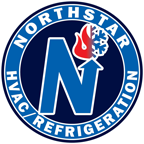Understanding the Total Cost of Ownership for HVAC & Refrigeration Systems
Written by Ed Rice
When evaluating HVAC and refrigeration systems, it’s tempting to focus only on the initial purchase price. But making a decision based solely on upfront cost can lead to long-term regrets. That’s why savvy facility managers, engineers, and business owners rely on a more comprehensive approach: understanding the Total Cost of Ownership (TCO).
TCO is the sum of all costs associated with owning, operating, maintaining, and eventually replacing your system. It’s the key to making informed decisions that maximize performance, minimize costs, and align with long-term business goals.
In this week’s blog, we break down what goes into TCO—and how Northstar Refrigeration can help you optimize every dollar you spend.
What Is Total Cost of Ownership (TCO)?
Total Cost of Ownership is a financial metric that considers all direct and indirect costs over the entire lifecycle of a system, not just the initial capital expenditure.
When it comes to HVAC and refrigeration systems, TCO includes:
Initial Equipment Cost
Installation and Commissioning
Energy Consumption
Maintenance and Service Costs
Downtime and Productivity Losses
Replacement Parts and Upgrades
Compliance and Safety Costs
End-of-Life Disposal or Replacement
Understanding each of these cost categories helps you make smarter investment decisions—and avoid surprises down the road.
Breaking Down the Components of TCO
Initial Equipment Cost
This includes the price of the HVAC or refrigeration unit, related components (pumps, coils, compressors), and accessories. While lower-cost systems may look appealing, they often come with trade-offs in efficiency, durability, and serviceability.
Pro Tip: Cheap upfront can often mean expensive long-term.
2. Installation and Commissioning
Proper installation and system startup ensure optimal performance. Poor design, improper charging, or rushed commissioning can cause premature failures and invalidate warranties.
Northstar Refrigeration delivers factory-authorized startup and system balancing to protect your investment from day one.
3. Energy Costs
Energy usage is often the largest component of TCO, especially in commercial and industrial environments where systems run 24/7.
High-efficiency equipment can reduce energy use by 20–50%
Variable speed drives, heat recovery, and smart controls all add long-term savings
Utility rebates and programs like Mass Save can help offset capital costs
Investing in energy efficiency is one of the fastest ways to lower TCO.
4. Maintenance and Service
Routine preventative maintenance extends system life and improves efficiency. But it also incurs labor, parts, and inspection costs over time.
Well-designed systems require fewer service calls
Easily accessible components reduce labor time
Digital monitoring can eliminate guesswork and predict failures
Partnering with Northstar means tailored maintenance plans designed to optimize TCO—not just respond to breakdowns.
5. Downtime and Productivity Loss
When systems fail, your business suffers.
For refrigeration: product spoilage, halted production, safety risks
For HVAC: uncomfortable occupants, lost tenant satisfaction, staff inefficiency
For both: expensive emergency repairs
Building in redundancy and keeping critical spare parts on hand reduces downtime risks significantly.
6. Compliance and Safety Costs
Staying in line with ASHRAE 15, IIAR standards, EPA refrigerant regulations, and local building codes isn’t just about avoiding fines—it’s about safety.
Modern systems that support A2L refrigerants, ammonia, or CO₂ are often built with advanced detection, ventilation, and control systems that safeguard both personnel and operations.
7. End-of-Life and Replacement
At the end of your system’s life, you’ll incur costs to remove, replace, and potentially retrofit surrounding infrastructure.
Choosing systems that offer:
Longer service life
Upgradeable components
Recyclable or eco-friendly refrigerants
…can reduce future costs and make replacement easier down the road.
The TCO Advantage: Example Scenario
Even though the VRF system has a higher upfront cost, it delivers $21,000 in TCO savings over 10 years through reduced energy use, fewer repairs, and longer service life.
How Northstar Refrigeration Helps You Optimize TCO
At Northstar Refrigeration, we don’t just sell equipment—we help you build lasting value into every system we install. Our approach includes:
Custom system design with energy modeling
Preventative maintenance plans that prevent costly failures
TCO-driven consultations and lifecycle cost analysis
Integration with available rebate and incentive programs
Long-term support for parts, upgrades, and compliance
Call us at (508) 888-3692 to discuss how to make smarter, cost-effective HVAC/R decisions for your facility.
Final Thoughts
Understanding the Total Cost of Ownership is critical to making informed, future-ready decisions for your HVAC and refrigeration systems. Focusing on upfront cost alone can lead to long-term pain—while factoring in energy, maintenance, downtime, and efficiency can deliver reliable performance and real savings.
Looking to lower your system’s TCO and boost your ROI? Partner with Northstar Refrigeration today and let’s plan your path to smarter HVACR investments.
(508) 888-3692
www.northstarhvacr.com



